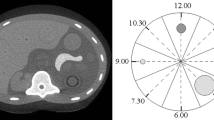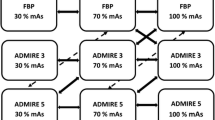Abstract
Objectives
To compare routine dose liver CT reconstructed with filtered back projection (FBP) versus low dose images reconstructed with FBP and adaptive statistical iterative reconstruction (ASIR).
Methods
In this retrospective study, patients had a routine dose protocol reconstructed with FBP, and again within 17 months (median 6.1 months), had a low dose protocol reconstructed twice, with FBP and ASIR. These reconstructions were compared for noise, image quality, and radiation dose.
Results
Nineteen patients were included. (12 male, mean age 58). Noise was significantly lower in low dose images reconstructed with ASIR compared to routine dose images reconstructed with FBP (liver: p < .05, aorta: p < 0.001). Low dose FBP images were scored significantly lower for subjective image quality than low dose ASIR (2.1 ± 0.5, 3.2 ± 0.8, p < 0.001). There was no difference in subjective image quality scores between routine dose FBP images and low dose ASIR images (3.6 ± 0.5, 3.2 ± 0.8, NS).Radiation dose was 41% less for the low dose protocol (4.4 ± 2.4 mSv versus 7.5 ± 5.5 mSv, p < 0.05).
Conclusions
Our initial results suggest low dose CT images reconstructed with ASIR may have lower measured noise, similar image quality, yet significantly less radiation dose compared with higher dose images reconstructed with FBP.

Similar content being viewed by others

References
Yanagawa M, Honda O, Yoshida S et al (2010) Adaptive statistical iterative reconstruction technique for pulmonary CT: image quality of the cadaveric lung on standard- and reduced-dose CT. Acad Radiol 17:1259–1266
Prakash P, Kalra MK, Kambadakone AK et al (2010) Reducing abdominal CT radiation dose with adaptive statistical iterative reconstruction technique. Invest Radiol 45:202–210
Prakash P, Kalra MK, Digumarthy SR et al (2010) Radiation dose reduction with chest computed tomography using adaptive statistical iterative reconstruction technique: initial experience. J Comput Assist Tomogr 34:40–45
Marin D, Nelson RC, Schindera ST et al (2010) Low-tube-voltage, high-tube-current multidetector abdominal CT: improved image quality and decreased radiation dose with adaptive statistical iterative reconstruction algorithm–initial clinical experience. Radiology 254:145–153
Hara AK, Paden RG, Silva AC, Kujak JL, Lawder HJ, Pavlicek W (2009) Iterative reconstruction technique for reducing body radiation dose at CT: feasibility study. AJR Am J Roentgenol 193:764–771
Flicek KT, Hara AK, Silva AC, Wu Q, Peter MB, Johnson CD (2010) Reducing the radiation dose for CT colonography using adaptive statistical iterative reconstruction: a pilot study. AJR Am J Roentgenol 195:126–131
Silva AC, Lawder HJ, Hara A, Kujak J, Pavlicek W (2010) Innovations in CT dose reduction strategy: application of the adaptive statistical iterative reconstruction algorithm. AJR Am J Roentgenol 194:191–199
Leipsic J, Labounty TM, Heilbron B et al (2010) Adaptive statistical iterative reconstruction: assessment of image noise and image quality in coronary CT angiography. AJR Am J Roentgenol 195:649–654
Sagara Y, Hara AK, Pavlicek W, Silva AC, Paden RG, Wu Q (2010) Abdominal CT: comparison of low-dose CT with adaptive statistical iterative reconstruction and routine-dose CT with filtered back projection in 53 patients. AJR Am J Roentgenol 195:713–719
Singh S, Kalra MK, Hsieh J et al (2010) Abdominal CT: comparison of adaptive statistical iterative and filtered back projection reconstruction techniques. Radiology 257:373–3836
Kanal KM, Stewart BK, Kolokythas O, Shuman WP (2007) Impact of operator-selected image noise index and reconstruction slice thickness on patient radiation dose in 64-MDCT. AJR Am J Roentgenol 189:219–225
AAPM Task Group 23 of the Diagnostic Imaging Council CT Committee (2008) The Measurement, Reporting, and Management of Radiation Dose in CT [AAPM Report 96]. American Association of Physicists in Medicine College Park, MD. Available via http://www.aapm.org/pubs/reports/RPT_96.pdf. Accessed 04 January 2011
Acknowledgement
This work was supported in part by an unrestricted grant for clinical research from GE Healthcare.
Author information
Authors and Affiliations
Corresponding author
Rights and permissions
About this article
Cite this article
Mitsumori, L.M., Shuman, W.P., Busey, J.M. et al. Adaptive statistical iterative reconstruction versus filtered back projection in the same patient: 64 channel liver CT image quality and patient radiation dose. Eur Radiol 22, 138–143 (2012). https://doi.org/10.1007/s00330-011-2186-3
Received:
Revised:
Accepted:
Published:
Issue Date:
DOI: https://doi.org/10.1007/s00330-011-2186-3



